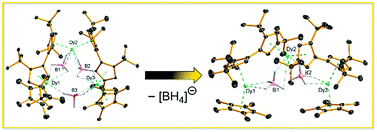Synthesis and single-molecule magnet properties of a trimetallic dysprosium metallocene cation†
Abstract
The dimetallic fulvalene-bridged dysprosium complex [{Dy(Cp*)(μ-BH4)}2(Fvtttt)] (1, Cp* = C5Me5) is converted into the trimetallic borohydride-bridged species [{Dy(Cp*)(Fvtttt)}2Dy(μ-BH4)3] (2). In turn, 2 is reacted with a silylium electrophile to give [{Dy(Cp*)(μ-BH4)(Fvtttt)}2Dy][B(C6F5)4] ([3][B(C6F5)3]), the first trimetallic dysprosocenium cation. Compound [3][B(C6F5)3] can also be formed directly from 1 by adding two equivalents of the electrophile. A three-fold enhancement in the effective energy barrier from 2 to 3 is observed and interpreted with the aid of ab initio calculations.



 Please wait while we load your content...
Please wait while we load your content...